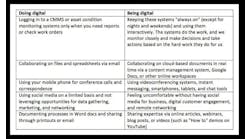By John Joseph, CEO & co-founder, Datanomix
Realizing the potential of Industry 4.0 necessitates embracing data-driven processes. Manufacturers already know that.
Unfortunately, outdated information systems, an aging workforce and anemic software tools have muddied the water. Instead of delivering clear production intelligence and making leadership decisions easy, they have done exactly the opposite: they have increased data-driven pressure.
This presents new opportunities, however. Amid the resurgence of manufacturing, understanding how to gather and act on real-time production data can improve a company’s competitive edge. When manufacturers embrace data-driven pressure, they make smarter business decisions and accelerate the continuous-improvement mindset on the shop floor.
The current landscape
Yes, manufacturing is alive and well (or it was prior to the pandemic), but there’s plenty of room for improvement.
While production equipment has kept up with innovations, information technology in the industry has not. As Baby Boomers age out of the workforce, they’re taking their specialized operating knowledge with them. They are being replaced, ideally, with specialized operators skilled at multitasking and reading digital output rather than being the “machine whisperers” of yesteryear. This is not always the case.
To truly maintain competitiveness against downward pressures on labor costs, today’s manufacturing leadership must make data-driven decisions. We knoe this. Unfortunately, many business owners have been burned even as they tried to implement data analytics. Too often, they have been lured by the promise of software tools that promise the moon and don’t deliver.
There’s a fundamental lack of trust due to poor execution, not understanding where the data lies, an an inability to read the data tea leaves. Current data-analytics approaches (think machine monitoring) are too static to help in the now—they often tell you tomorrow what happened yesterday. Or they require machines to be bristling with IIoT sensors to deliver predictive maintenance, which might be useful but ignores a company’s path on the road to a truly “smart” factory. Frustrated by both approaches to data, discrete component manufacturers are often looking for a Goldilocks solution.
Fortunately, there is a better way.
Real-time production monitoring works with latent assets already on the plant floor. In a short period of time we can learn a company’s production capabilities—for every job and every machine. The system does not require any human input, and constantly factors in historical context on performance and other production parameters to gain a new level of production intelligence. Manufacturers no longer have to depend on worker intuition to know when something is awry on the shop floor.
Equally important, real-time production monitoring solutions can be crafted to be easily understood so production-line workers can respond to dips by taking corrective action. They react to problems in real time, meeting key metrics every day.
Take the next step
Manufacturers need to first survey their systems to understand what’s working and what’s not. They might have to commit to a reboot—reengineering old models and cutting the cord to systems that don’t work. Not always an easy task.
Real-time production intelligence software is accessible, customizable and delivers a modern approach to data. It learns machine behavior for each job, cuts through the noise and zeros in on problems to optimize production every day.
Working with antiquated toolsets in today’s global, modern industrial landscape just doesn’t make sense. Don’t fear data-driven pressure...embrace it with production-intelligence software.


